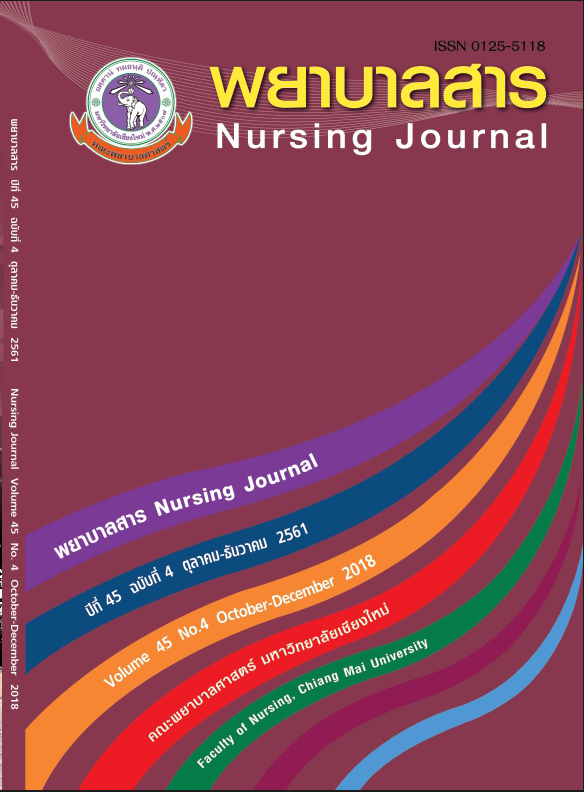การส่งเสริมพฤติกรรมบิดามารดาในการป้องกันการบาดเจ็บจากอุบัติเหตุแก่เด็ก
คำสำคัญ:
การส่งเสริมบิดามารดา, การป้องกันการบาดเจ็บจากอุบัติเหตุแก่เด็กบทคัดย่อ
การบาดเจ็บจากอุบัติเหตุในบ้านและรอบๆบ้านเป็นสาเหตุสำคัญของการเสียชีวิตในเด็กอายุต่ำกว่า 5 ขวบโดยเฉพาะอย่างยิ่งมักเกิดขึ้นขณะที่เด็กอยู่ภายใต้การดูแลของผู้ปกครอง การเปลี่ยนแปลงพฤติกรรมของบิดามารดาเป็นสิ่งจำเป็นเพื่อลดความเสี่ยงต่อการบาดเจ็บในเด็กเล็กจากอุบัติเหตุที่บ้าน ปัจจัยสำคัญที่มีอิทธิพลต่อพฤติกรรมการป้องกันการบาดเจ็บจากอุบัติเหตุที่บ้านของเด็กเล็กในครอบครัวไทย ได้แก่ ความรู้ความตระหนักความวิตกกังวลและเจตนาของบิดามารดา บทบาทของผู้ดูแลสุขภาพเด็กรวมถึงพยาบาลในการส่งเสริมให้บิดามารดามีความเข้าใจมากขึ้นเกี่ยวกับการเกี่ยวกับการป้องกันการบาดเจ็บจากอุบัติเหตุในบ้านในเด็กเล็กโดยใช้แนวคิดการเสริมสร้างพลังอำนาจของกิบสันมาประยุกต์ใช้ในการพัฒนาพฤติกรรมของผู้ปกครองให้มีการป้องกันการบาดเจ็บดังกล่าวนับเป็นประโยชน์อย่างยิ่งสำหรับการสนับสนุนองค์ความรู้ด้านการพยาบาลเด็กและผู้ให้บริการด้านการดูแลสุขภาพในการกำหนดนโยบายด้านสุขภาพของเด็กและพัฒนาแผนการสร้างเสริมสุขภาพเด็ก
References
Bandura, A. (1997). Self-efficacy: The exercise of control. New York: Freeman.
Centers for Disease Control and Prevention. (2012). Vital Signs: Unintentional injury deaths among persons aged 0-19 years–United States, 2000-2009. Morbidity and Mortality Weekly Report, 61(15), 270-276.
Child Safety Promotion and Injury Prevention Research Centre. (2014). Safe products for children. Retrieved 5 November 2016, from Child Safety Promotion and Injury Prevention Research Centre http://www.csip.org/
Conner, M. & Sparks, P. (2005). Theory of planned behaviour and health behaviour
In M. N. Conner, P. (Ed.), Predicting health behaviour (pp. 170-222). London: Bell & Bain.
Gibson, C.H. (1993). Empowerment theory and practice with adolescents of colour in the child welfare system. Families in Society, 74(7), 387-396.
Irving, L. (2011). Preventing unintentional injuries in children and young people under 15. Community Practitioner 84(3), 36-38.
Jonkheijm, A., Zuidgeest, J.J., Dijk, M., & Van, AS. AB. (2013). Childhood unintentional injuries: supervision and first aid provided. African Journal of Paediatric Surgery, 10(4), 339-344.
Kendrick, D., Young, B., Mason-Jones, A.J., Ilyas, N., Achana, F.A., Cooper, N.J., Hubbard, S.J., Sutton, A.J., Smith, S., Wynn, P., Mulvaney, C., Watson, M.C., & Coupland, C. (2013). Home safety education and provision of safety equipment for injury prevention (review). Evidence Based Child Health, 8(3), 761-939.
Long, T. (2007). What are the ethical issues in research? In C. Webb, Johnson, M., &Long, T (Ed.), Research ethics in the real world: Issues and solutions for health and social care (pp. 47-62). China: ELSEVIER.
Morrongiello, B.A. & McArthur, B.A. (2010). Parent supervision to prevent injuries. Retrieved 28 April 2017, from Centre of Excellent for Early Childhood Development
http://www.child-encyclopedia.com/sites/default/files/textes-experts/en/654/parent-supervision-to-prevent-injuries.pdf
Munro, S.A., Niekerk, A.V. & Seedat, M. (2006). Childhood unintentional injuries: The perceived impact of the environment, lack of supervision and child characteristics. Child: Care, Health & Development, 32(3), 269-279.
Nansel, T.R., Weaver, N.L., Jacobsen, H.A., Glasheen, C. & Kreuter, M.W. (2008). Preventing unintentional pediatric injuries: A tailored intervention for parents and providers. Health Education Research, 23(4), 656-669.
National Statistical Office, Thailand. (2014). Family statistics. Retrieved 28 April 2017, from service.nso.go.th/nso/nsopublish/citizen/news/news_family.jsp
Ngamsuoy, A. (2014). Developing a parental behaviour programme for child home injury prevention in Thailand: Parents’ experiences and perceptions. Doctoral Dissertation. Newcastle upon Tyne: Northumbria University Library.
Payne, B.K. (2012). Control, awareness, and other things we might learn to live without In S. T. M. Fiske, C.N (Ed.), The sage handbook of social cognition (pp. 12-30). London: SAGE.
Pearson, M., Garside, R., Moxham, T. & Anderson, R. (2011). Preventing unintentional injuries to children in the home: A systematic review of the effectiveness of programmes supplying and/or installing home safety equipment. Health Promotion International, 26(3), 376-392.
Peden, M., Oyegbite, K., Ozanne-Smith, J., Hyder, A.A., Branche, C., Rahman, A.F., & et al. (2008). World report on child injury prevention: Geneva: WHO & UNICEF.
Phelan, K.J., Khoury, J., Xu, Y., Liddy, S., Hornung, R., & Lanphear, B.P. (2011). A randomized controlled trial of home injury hazard reduction. Formerly Archives of Paediatric & Adolescent Medicine, 165(4), 339-345.
Rachman, S. (2013). Anxiety (3rd ed.). New York: Psychology Press.
Reeve, J. (2009). Understanding motivation and emotion (5th ed.). New Jersey: John Wiley & Son, Inc.
Stringer, E.T. (2014). Action research (4th ed.). London: Sage.
Unicef, World Health Organization, World bank group, & United nations. (2017). Levels & trends in child mortality Retrieved 28 September 2018, from https://www.unicef.org/publications/files/Child_Mortality_Report_2017.pdf
Van, AS.AB. & Stein, D.J. (2010). Child safety: A neglected priority. World Journal of Pediatrics 6(4), 293-295.
World Health Organization. (2010). Profile of child injuries: selected member states in the Asia-Pacific region. New Delhi: Regional office for South-East Asia.
Downloads
เผยแพร่แล้ว
How to Cite
ฉบับ
บท
License
บทความที่ได้รับการตีพิมพ์เป็นลิขสิทธิ์ของวารสารพยาบาลสาร
ข้อความที่ปรากฏในบทความแต่ละเรื่องในวารสารวิชาการเล่มนี้เป็นความคิดเห็นส่วนตัวของผู้เขียนแต่ละท่านไม่เกี่ยวข้องกับมหาวิทยาลัยเชียงใหม่ และคณาจารย์ท่านอื่นๆในมหาวิทยาลัยฯ แต่อย่างใด ความรับผิดชอบองค์ประกอบทั้งหมดของบทความแต่ละเรื่องเป็นของผู้เขียนแต่ละท่าน หากมีความผิดพลาดใด ๆ ผู้เขียนแต่ละท่านจะรับผิดชอบบทความของตนเองแต่ผู้เดียว





